Exhibition dates: 24th March – 30th July 2017
Poul C Poulsen (Australian born Denmark, 1857-1925)
Bushman with a swag
c. 1885
Cabinet photograph
This exhibition looks fascinating. I wish I could have seen it!
Information about some photographers is included in the posting, as much as I could find through research online. Also included is a beautiful photograph of the Cloudland Ballroom (not in the exhibition) which I digitally restored.
I tried to work out the height of the young man in Bushman with a swag (c. 1885, above). If you take the billy can at his feet (bottom left) at about 24cm, measured by my ankles, then his height is around 180cm or 5’9″. What was his name, what did he do in his life?
Also notice the covers on his shoes that hide the laces, and the idyllic, painted pastoral backdrop with bridge. These are the details that fascinate. The studio prop of a rock outcrop against which he stands also appears in another image by the same photographer, Queensland policeman (c. 1885, below). How many days or months were these photographs taken apart? Did they know each other, being of similar age?
The presence of the people in these photographs is incredible. Even though they are posed, they stare back at us from across time and reach out to us to speak of their lives in that moment, in that studio in Brisbane, Australia.
Dr Marcus Bunyan
Many thankx to the Museum of Brisbane for allowing me to publish the photographs in the posting. Please click on the photographs for a larger version of the image.
Poul C Poulsen (Australian born Denmark, 1857-1925)
Bushman with a swag (detail)
c. 1885
Cabinet photograph
The Poulsen Studio was a very important establishment recording Queensland’s development for a considerable period of time.
Poul C. Poulsen, founder of the Poulsen Studios in Brisbane, was born in Denmark in 1857 and arrived in Sydney in 1876. In 1882, he moved to Queensland and was later joined by his sisters and brothers from Denmark. He opened his own studio at no 7 Queen Street in 1885 and later opened branches, run by his brothers in other Queensland towns. Poulsen vigorously advertised constant improvements and modernisation in his studio and in the service he provided. His sons and grandson followed in his footsteps.
Text from the State Library of Queensland website
Installation views of the exhibition Sit. Pose. Snap. Brisbane Portrait Photography 1850-1950 at the Museum of Brisbane
Sit. Pose. Snap. Brisbane Portrait Photography 1850-1950 explores the phenomenon of studio portrait photography in Brisbane, and shows how the process of capturing and sharing a portrait evolved from the formal studio sittings of the 19th century through to candid and relaxed photographs of the mid-20th century.
With the introduction of commercial photography in the mid 1850s, dozens of photographic studios popped up in and around Brisbane capitalising on this popular new technology. Interest in this novel sensation was high, and profitable – with photographers increasingly savvy when it came to selling their service and products.
Featuring hundreds of Brisbane residents captured in original photographs from local studios between 1850-1950, this exhibition draws from the extensive private collection of Marcel Safier – one of Australia’s most significant collectors of portrait photography. Discover the variety, trends and historical progression of photographic types through this period, from the early forms of daguerreotypes through to carte-de-visites and postcards. Woven into the exhibition is an examination of photographic techniques and technologies; the popularisation of photography; and the ever-increasing control that subjects have over their portrayal.
Significant Brisbane photographic houses of the period and their legacies are also featured. Visitors will have the chance to experience what it felt like to visit Mathewson & Co., one of the leading studios of the time, through an immersive Victorian backdrop and a journalist’s account from 1889. They will also have a chance to take a selfie in this recreated 19th century studio space.
From personal portraits capturing life’s most significant milestones, to the curious and often humorous ways in which people presented themselves, Sit. Pose. Snap. is a charming and nostalgic glimpse into a 19th century photographic studio.
Press release from the Museum of Brisbane
Daniel Marquis (Australian born Scotland, 1829-1879)
The same woman in a crinoline dress posing with a chair, then a pedestal
1865-1870
Carte de visite
Daniel Marquis (Australian born Scotland, 1829-1879)
The same woman in a crinoline dress posing with a chair, then a pedestal
1865-1870
Carte de visite
Daniel Marquis (1829-1879) was an early portrait photographer in Brisbane, Australia. Marquis was born in Glasgow, Scotland, where he had a studio as a professional photographer at 32 King Street, Stirling. Marquis travelled to Australia in 1865 and was given a land grant at Kangaroo Point, Queensland. He set up his photographic studio in 82 George Street, Brisbane, from 1866 to 1880.
Marquis was one of the earliest portrait photographers in Brisbane, working there exclusively until his death in 1879. Marquis had commissions to photograph leading members of society, for example the Governor of Queensland, Samuel Wensley Blackall, and Judge Alfred Lutwyche.
Text from the Wikipedia website
Andrew Weddell (active 1864-1874)
Reproductions of a recently deceased man requested by the family
c. 1870
Carte de visite
Andrew Weddell (active 1864-1874)
Reproductions of a recently deceased man requested by the family
c. 1870
Carte de visite
Located at Ann Street, Fortitude Valley, Brisbane, Queensland from 1864-1874.
Andrew Weddell (active 1864-1874)
Three men acting for the camera
c. 1870
Carte de visite
Andrew Weddell (active 1864-1874)
Three men acting for the camera
c. 1870
Carte de visite
Elite Photo Co., (Eddie Hutchison)
Girl in ballet shoes, with pigeons
1884-1891
Cabinet photograph
1884-1890: 8 Queen Street, Brisbane
Eddie T B Hutchison
1889: McDougal Terrace, Milton Estate
1895-1896: 183 Queen Street, Brisbane
1896-1897: 181A Queen Street, Brisbane
1897-1899: 37 Queen Street, Brisbane
1900: Warwick
Alan Davies and Peter Stanbury. The mechanical eye in Australia: photography 1841-1900.
“Oscar [Friström] was soon involved in the business of photography, a popular artistic and cultural pursuit of the time; and it was also a ready source of income. By 1885 he had gone into partnership with the established photographer D Hutchison, and later Edward TB Hutchison. The business operated under various names, including Hutchison, Fristrom and Company and Elite Photographic Company.”
Julie K Brown, Versions of reality, PhD thesis, University of Queensland, 1984, pp. 37, 274 cited in W Ross Johnston. “Reviving Oscar Friström: his Aboriginal paintings,” in the Queensland History Journal Volume 22, No. 4, February 2014, p. 272.
Elite Photo Co’s dates and locations from Alan Davies’ and Peter Stanbury’s book The mechanical eye in Australia: photography 1841-1900:
1894-1895: Charters Towers
Brisbane
(Eddie T B Hutchison)
Brisbane
(John S Wiley)
Brisbane
(S E Hill)
Brisbane
(J Brame & Co)
cabinet: Crown Street, Wollongong, NSW
1890: Wagga Wagga, NSW, late Fiddes
Eddie Hutchison
Freemason Elite
c. 1900
Cabinet photograph
Eddie T B Hutchison’s dates and locations from Alan Davies’ and Peter Stanbury’s book The mechanical eye in Australia: photography 1841-1900:
1884-1890: 8 Queen Street, Brisbane
Eddie T B Hutchison
1889: McDougal Terrace, Milton Estate
1895-1896: 183 Queen Street, Brisbane
1896-1897: 181A Queen Street, Brisbane
1897-1899: 37 Queen Street, Brisbane
1900: Warwick
Poul C Poulsen (Australian born Denmark, 1857-1925)
Queensland policeman
c. 1885
Carte de visite
In 1885, Poul C. Poulsen opened his photographic studio at No.7 Queen Street in Brisbane and over time established himself as an important and longstanding early Queensland photographer. State Library of Queensland is fortunate to hold a large collection of photographs taken by the Poulsen Studios.
Polsen was born in Denmark in 1857 and travelled to Sydney in 1876. In 1882 he travelled to Brisbane and in 1885 opened the studio in Queen Street, previously occupied by Gove and Allen, photographers. Via advertisements in local newspapers that year Poulsen proclaimed himself “the people’s favourite photographer” and offered “high class work at moderate charges.” Poulsen’s success enabled him to expanded his business, opening studios in regional centres including Gympie, Maryborough and Laidley as well as additional studios in Brisbane. Poulsen retired to Cooran in 1915, passing away in 1925. He is interred at Bulimba Cemetery. His sons and grandsons continued the family business after his death.
Hundreds of images taken by Poulsen Studios have been digitised and can be viewed online. These photographs range from individual or group portraits to external street views. The quality of these images are superb, most likely due to Poulsen’s desire to use the latest photographic equipment available at the time.
Myles Sinnamon. “Early Queensland photography – Poulsen Studios,” on the State Library of Queensland website September 15, 2015 {online] Cited 10/03/2023
Poul C Poulsen (Australian born Denmark, 1857-1925)
Unknown couple
c. 1897
Cabinet photograph
Marcel Safier collection
Directly opposite Fegan Studios on Queen Street was the studio of Ada Driver. Driver was one of the successful female photographers in Brisbane in the early 20th century, along with Elsie and Trissie Deazeley, Mary Lambert and Dorothy Coleman.
Before starting her own studio, Coleman had gained experience as a camera operator with Thomas Mathewson. Mathewson, along with Poul C Poulsen, set the standard of quality for portrait photography in Brisbane; between them they trained and inspired future generations of photographers.
Poulsen moved to Brisbane in 1882 and opened a branch of Gove and Allen opposite the Treasury Building on Queen Street.
This studio was later known as the American Photo Co, and then Poulsen Studios (below), and remained at this location until 1918. The studio was considered the major ‘society’ studio in Brisbane; Poulsen established a reputation for taking fine portraits of stars of the stage, including Dame Nellie Melba in 1903, and he secured the patronage of several Queensland governors.
Phil Manning. “Northern Exposure,” in Portrait 57 Winter 2017 on the National Portrait Gallery website 25 July 2017 [Online] Cited 13/12/2021
Poulsen Studio
Child with bucket and spade
1920s
Postcard
Albert Lomer & Co., (Albert Lomer Australian, 1862-1899, active c. 1865 – c. 1895)
Three children
c. 1885
Cabinet photograph
Professional photographer and colourist of Brisbane, Sydney and Queensland who worked throughout the mid to late 19th century. A one-time partner of Andrew Chandler, Lomer’s later clients included the painter Samuel Elyard.
Lomer worked in Melbourne before 1865 when he opened a studio at Sydney in partnership with Andrew Chandler. They advertised as being from W. Davies & Co. of Melbourne, where both had presumably trained. Their studio, The London Photographic Company, was at 419 George Street, next door to Lassetter’s ironmongery store. By February 1867 Lomer was continuing alone but promising that ‘the business will be conducted in the same efficient manner and under the same liberal principles as hitherto’. He had reduced the old price for cartes-de-visite to two for 5s or 15s a dozen and sold cabinet and other portrait photographs ‘beautifully coloured (on the premises) in oil or water’. Lomer appears to have been his own colourist, regularly advertising as both ‘artist and photographer’ (which this normally signified). In 1872-73 Lomer was working at 57 Bourke Street, Melbourne. He then established a very successful Brisbane studio at 158 Queen Street which lasted from 1874 until 1905, although he apparently no longer ran it after 1880. Branch studios were opened in various parts of the colony: the Lomer studio at Mackay in 1887 (managed by J.P. Kemp), a studio at Toowoomba (1893-96) and one at Ipswich (1898-99). Lomer was again in Sydney in 1880-95. In April 1881 Albert Lomer’s Parlour Studios at 805 George Street opposite the railway terminus,’The Really Popular (and Cheap) Photographer’, was selling cartes-de-visite for 7s 6d a dozen.
Anonymous text. “Lomer, Albert (1862-1899),” on the Trove website [Online] Cited 13/12/2021
1862: Brisbane
1865-1870: 417-419 George Street, Sydney
18??: 775 George Street, Sydney
1872-1873: 57 Bourke Street East, Melbourne
1874-1900: 158 Queen Street, Brisbane
1887: Mackay, Queensland ( J P Kemp)
1893-1896: Toowoomba, Queensland
1894-1895: 158 Queen Street, Brisbane (G A Collins & F T E Keogh)
1896-1897: 158 Queen Street, Brisbane (G A Collins)
1898-1899: Brisbane Street, Ipswich, Queensland
Alan Davies and Peter Stanbury. The mechanical eye in Australia: photography 1841-1900.
Tuttle & Co.,
Lady in a heavily beaded bodice and skirt
1885-1894
Cabinet photograph
William Nutting Tuttle
died 7 April 1895 at Sydney Hospital, Macquarie Street, Sydney
buried Waverley Cemetery, Sydney
William Nutting Tuttle and Co. was a commercial photographic firm active in Australia in the 1880s and 1890s. The firm had various studios and were active in a variety of areas: Sydney 1883-91; Goulburn 1895; Brisbane 1885-95; Charters Towers 1888; Adelaide 1882-89; Melbourne 1881-94; Hawthorn 1888-89; Perth 1892, Fremantle 1892; Coolgardie 1895-96 (Davies and Stanbury 1985, p. 244).
“The enterprising gentlemen comprising the firm of Tuttle & Co. took the people of Melbourne by surprise some five years ago [1880]. Since then they have established studios and galleries in the principal cities of Australia. By careful attention to, and despatch of business, the elegance and attractiveness of their rooms, and the splendid finish of their work, they have earned a wide-spread reputation on the island continent, and lead the van there in the photographic art.”
1885-1895: 67 Queen Street, Brisbane
1888: Charters Towers, Queensland
1883-1891: 84 Elizabeth St., Melbourne
Alan Davies and Peter Stanbury. The mechanical eye in Australia: photography 1841-1900, p. 244.
Tosca Studio
Couple with child
1896-1900
Cabinet photograph
The management of the “Tosca” studios in Brisbane make it their proud boast that they are thoroughly up to date in every detail, and in this they challenge comparison with any photographic establishment in the Australian colonies. Their head studios, at 67 Queen-street, Brisbane, are known to all local residents, and since the commencement of their business a reputation has been established for high class work not only in the city of Brisbane, but throughout Queensland. Mr. W. T. Farrell, in whose hands is the sole control of the business, is a man of the widest range of experience in his particular line. He has gained his knowledge in the leading studios of Australasia. The high character of the work produced is vouched for by the fact that the chief operator, Mr. Stuart MacQee, was for many years under engagement to Messrs. W. and D. Downoy, Imperial Court photographers, of Ebury street, London, and was also five years with Messrs. Falle and Co., of Sydney. Branches of the “Tosca” studios have already been established at Gympie, Rockhampton, Charters Towers, and Townsville. It is also contemplated to establish branches in other country towns in the near future. As indicating the amount of business transacted, it may be mentioned that during the present year no fewer than 200,000 cabinet mounts have been imported by the firm. This is exclusive of mounts required for Paris panels, for which there is a very large demand. In the head studio alone, as much as £88 has been taken in one day from sitters.
Anonymous text. “The Tosca Portrait Studios,” in The Brisbane Courier Sat 11 Dec 1897, p. 6 on the Trove website [Online] Cited 13/12/2021
Dana Studio
Lady wearing gloves with parasol
1897-1898
Cabinet photograph
James Patching & Co.,
Young lady in feathered hat leaning on bamboo furniture
1897-1901
Cabinet photograph
John Wiley (active 1880s – 1890s)
Seated lady holding flowers
1899-1901
Cabinet photograph
John S Wiley’s dates and locations from Alan Davies’ and Peter Stanbury’s book The mechanical eye in Australia: photography 1841-1900:
Lomer & Co, Brisbane
Tuttle & Co, Brisbane
Toowoomba
1890-1894 8 Queen Street, Brisbane
Elite Photo Co
1894-1900 10 Queen Street, Brisbane
Thomas Mathewson & Co., (active c. 1854 – c. 1934)
Two Salvation Army girls
1910-1915
Postcard
Thomas Mathewson (born Helensburgh, Dumbartonshire, Scotland, UK, 1842 – died Brisbane 12 May 1934; arrived Australia 1853) was a professional photographer, was born in Helensburgh, Dumbartonshire, Scotland. He was orphaned in early adolescence, shortly after his family migrated to Moreton Bay, Queensland, in 1853. For a few months in 1854 he attended the Anglican Church School in Nicholas Street, Ipswich run by Alfred Hazelton, then learnt photography from Rev. Theophilus Beazeley in evening self-improvement classes at Ipswich. After practising as an amateur Mathewson set up as a professional photographer at Toowoomba in 1861. In 1865 he worked his way through the Darling Downs, via Roma, St George and the Gwydir River, reaching Sydney by late 1867. Travelling northwards, he took photographs at Gympie (1868-72), Rockhampton, Bowen, Charters Towers and Townsville.
Thomas’s brother Peter joined him in 1876 and the firm became Mathewson & Co. until the 1890s, operating mainly from Queen Street, Brisbane, but making regular tours to country towns and rural districts. Thomas, the senior partner, was said in 1894 to have made a speciality ‘of children and other pets’. Peter set up on his own in the late 1890s and his son Thomas eventually took over the firm, so the name Thomas Mathewson was associated with two separate Brisbane photographic studios. Thomas senior eventually renamed his business the Regent Studios, where he was assisted by his son Jack. Thomas junior called his father’s business the Austral Studio when he inherited it.
Thomas Mathewson senior died in Brisbane on 12 May 1934, aged ninety-three. Recognised as the ‘Grand Old Man’ of Queensland photography, he was said in 1894 to have left the ‘tracks of his tripod’ in every inhabited place from the Great Barrier Reef to the South Australian border. Before his death he wrote his recollections, depicting the excitement, initiative and hardships of an early cameraman as he trekked through the countryside ‘fully equipped with tents, one in which to photograph sitters, and another in which to live, together with all the needful paraphernalia of wet-plate photography, all packed in a two-wheeled vehicle drawn by two horses’.
Rod Fisher and Joan Kerr. “Thomas Mathewson,” on the Design & Art Australia Online website 1992 last updated 2011 [Online] Cited 13/12/2021
c. 1854: Ipswich, Qld
c. 1853 – c. 1854: Moreton Bay, Qld
c. 1867: Sydney, NSW
c. 1865 – c. 1867: Gwydir River, NSW
c. 1865 – c. 1867: St George, Qld
c. 1865 – c. 1867: Roma, NSW
c. 1868 – c. 1872: Townsville, Qld
c. 1868 – c. 1872: Charters Towers, Qld
c. 1868 – c. 1872: Bowen, Qld
c. 1868 – c. 1872: Rockhampton, Qld
c. 1868 – c. 1872: Gympie, Qld
c. 1865 – c. 1867: Darling Downs, NSW
c. 1861 – c. 1865: Toowoomba, Qld
c. 1876 – c. 1900: Queen Street, Brisbane, Qld
Thomas Mathewson & Co., (active c. 1854 – c. 1934)
Thomas Mathewson (inset) and his studio on Queen Street
c. 1908
Sandy Barrie collection
Thomas Mathewson is regarded as the father of photography in Queensland, having begun his business in 1864 (the Mathewson family would go on to have a presence in Brisbane’s photographic community until 1940). It is said that Mathewson left the tracks of his tripod in every inhabited place from the Great Barrier Reef to the South Australian border. He returned to Brisbane in 1876, going into partnership with his brother, Peter, in a studio on Queen Street. In 1895 they ended the partnership and Thomas continued on his own, establishing Regent Studios, while Peter established Austral Studios. Both brothers established branches of their respective operations throughout Queensland.
Phil Manning. “Northern Exposure,” in Portrait 57 Winter 2017 on the National Portrait Gallery website 25 July 2017 [Online] Cited 13/12/2021
Thomas Mathewson & Co., (active c. 1854 – c. 1934)
Lady in ‘snow’
c. 1880-1885
Cabinet photograph
Marcel Safier collection
Regent Studios (Thomas Mathewson)
Jane and Thomas Mathewson
1920s
Card-mounted sepia-toned silver gelatin photograph
Talma Studios (Ferdinand Sturgess) (Brisbane, 1866-1939)
Arthur Kean playing a flute
1915
Postcard
John ‘Jack’ Fegan (Australian, 1839-1919)
Lady holding flowers
c. 1915
Postcard
Jack Fegan was born John James William Rolling Fegan in 1839 and died in 1919. He operated photographic studios in Gympie and Brisbane. He was the first president of the Professional Photographers of Queensland.
Fegan & Ruddle
1902-1904: Brunswick St. Fortitude Valley
1918-1920: 126 Queen St. Brisbane
Fegan Ltd.
126 Queen St. Bris. 1918 -1920.
Fegan Studios
Mrs Fegan (wife of “Jack”, manager after Jack’s death in 1922)
126 Queen st,. Bris.
John ‘Jack’ Fegan (Australian, 1839-1919)
Family portrait before the father left for the First World War
1914-1918
Postcard
Fegan & Ruddle (1866-1939, Brisbane)
Harry Smith Jr dressed as Duke of York for Children’s Hospital Ball
1902
Cabinet photograph
George Brown
Girl with fancy buckled shoes
1912-1928
Postcard
Murray Studios (Brisbane & Gympie)
The Noonans
1916-1919
Postcard
George Hendry
Norma Horniblow in a bathing costume
c. 1920
Parisian Studio Postcard
Norma Gwendoline Horniblow (1904-1977)
Trissie Deazeley Studio (active c. 1924 – c. 1928)
Wedding party
c. 1925
Silver gelatin photograph
Trissie Deazeley (active c. 1924 – c. 1928) was an early 20th century Queensland photographer.
One of the first female photographers in Brisbane was Ada Driver, whose Brisbane studio was right in Queen Street Mall along with other female photographers Trissie Deazeley, Dorothy Coleman and Mary Lambert.
c. 1927 – c. 1928: Brisbane, Qld
c. 1924 – c. 1927: Toowoomba, Qld
Trissie Deazeley Studio (active c. 1924 – c. 1928)
Wedding party (details)
c. 1925
Silver gelatin photograph
Regent Studios (Fred Cherry)
Girl holding a toy koala and boy holding a toy car
1940s
Sepia-toned silver gelatin photograph in presentation folder
Anna Lee
Group of friends at Cloudland Ballroom, including Mrs Hobson (front left)
1947-1950
Salon Postcard
Read the fascinating history of Brisbane’s most iconic building, the big arch on the hill that was the Cloudland Ballroom.
“Cloudland Dance Hall” at the time, builders declared, “With its private alcoves, upholstered seating, dressing rooms, and perfect ventilation… the ballroom will be the finest of its kind in Australia.” It was no exaggeration, and Cloudland was without doubt one of the best dance and concert venues in the country. The venue was a classic World War II structure. Inside it had hard timber floors, decorative columns, sweeping curtains, domed skylights and chandeliers. Cloudland also had an upper circle of tiered seating which overlooked the floor and stage.
On a commanding hilltop site in the Bowen Hills above Brisbane, Cloudland’s distinctive parabolic laminated roof arch, nearly 18 meters high, was visible for miles, and was illuminated at night. Inside, as the photo clearly shows, it was famed for elegant decoration and its sprung dance floor, reputed to be the best in Australia. Cloudland was significant as a landmark, and as a place where generations of Brisbane residents went for entertainment. It was illegally demolished in 1982.
Unknown photographer
Cloudland Ballroom (digitally restored by MB)
Nd
Paragon Portraits
Tim, nearly 4 years-old, and Darryl, 2 years-old, at the Caldwell Christmas party
1949
Hand-coloured postcard
Museum of Brisbane
Level 3, Brisbane City Hall
King George Square, Brisbane
Opening hours:
Open 7 days a week, 10am – 5pm daily, and until 7pm Fridays




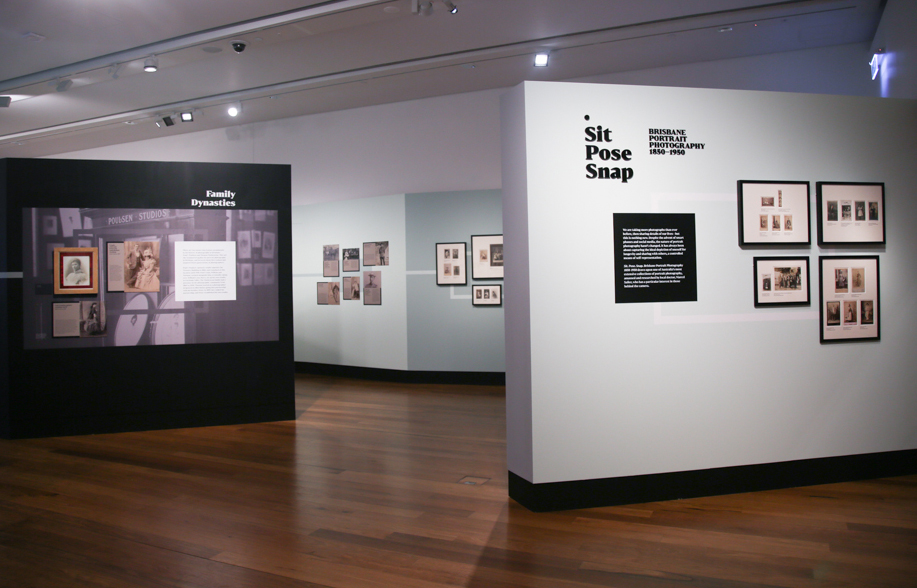

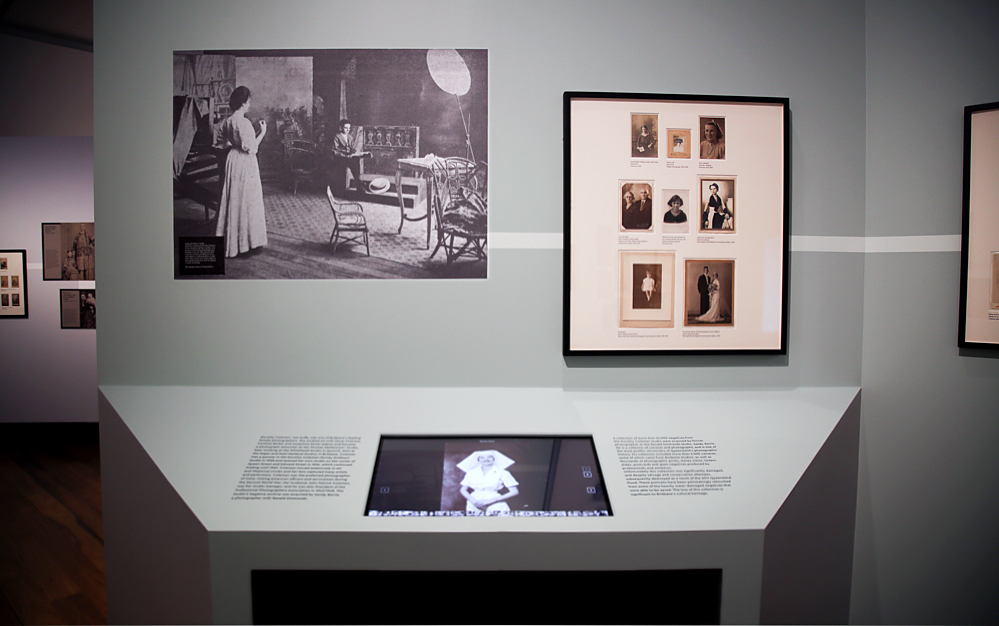
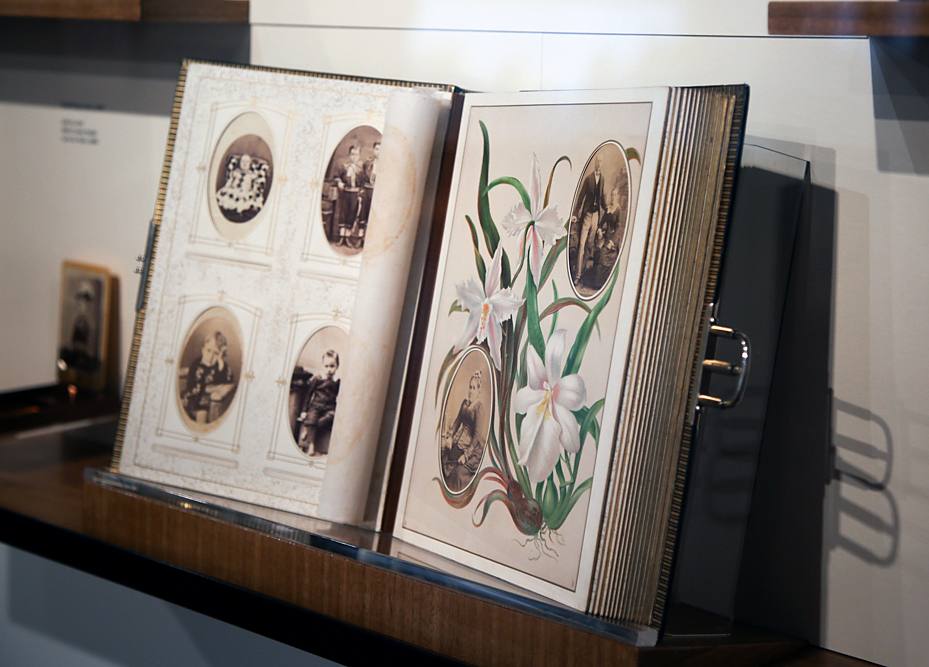
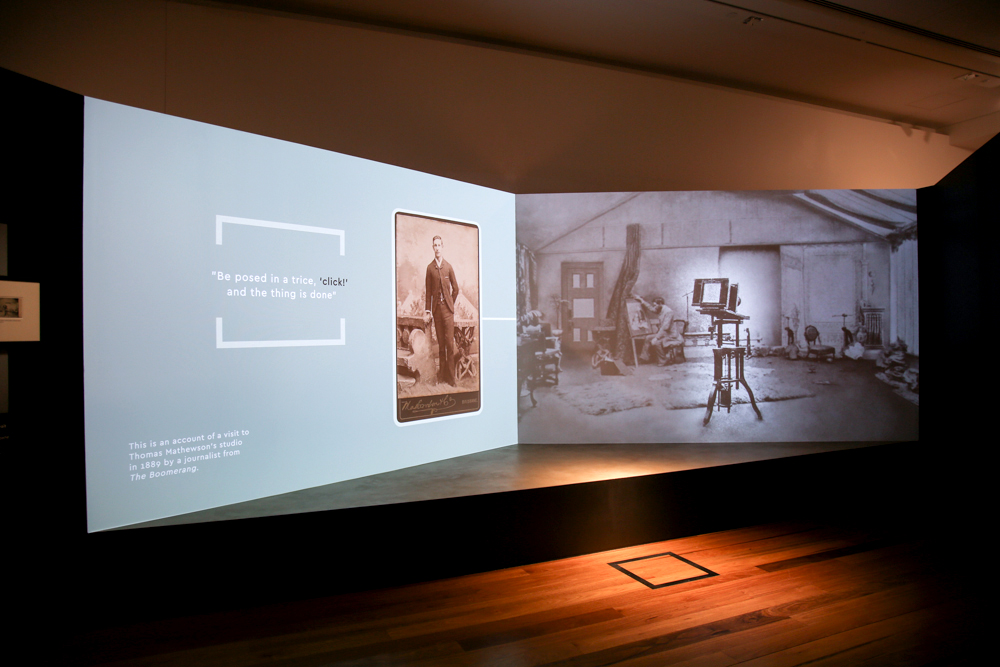

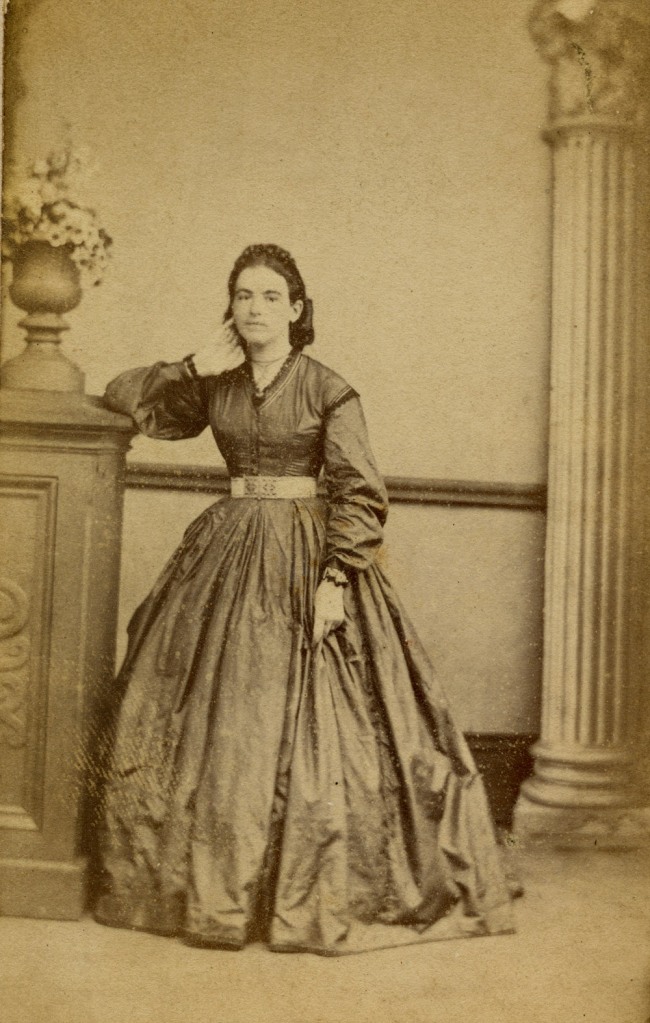



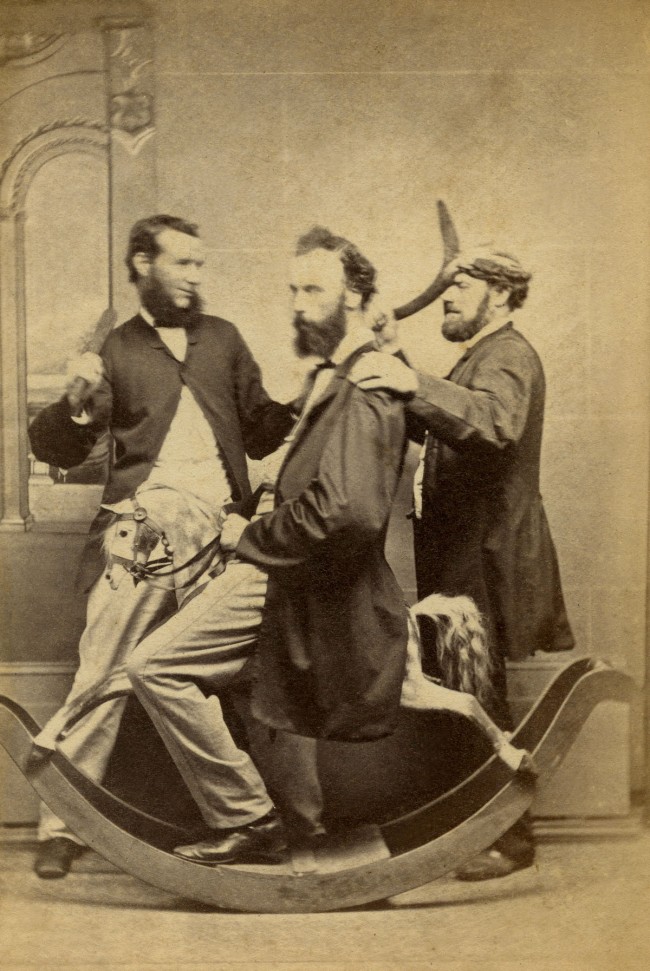

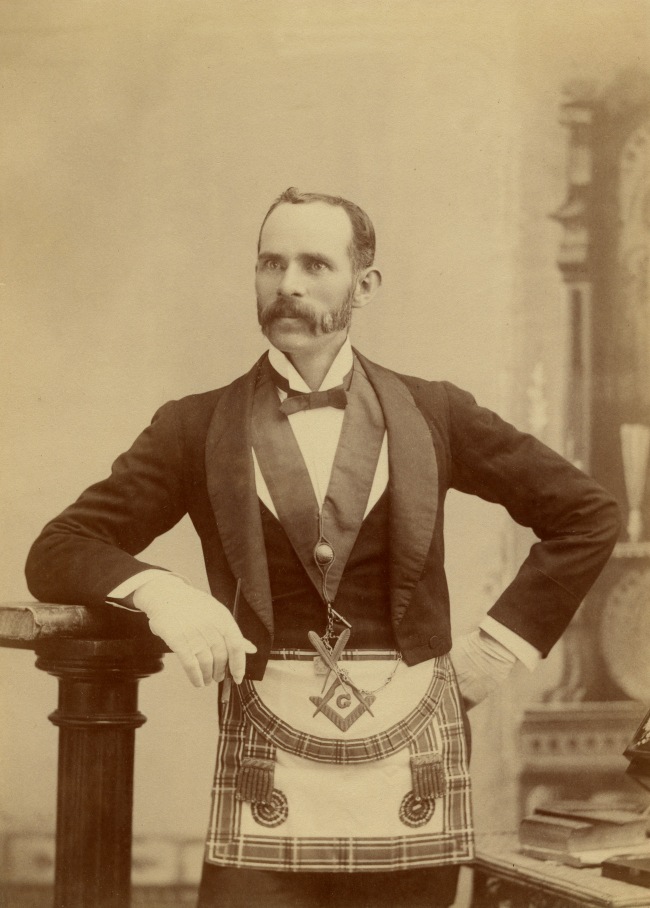





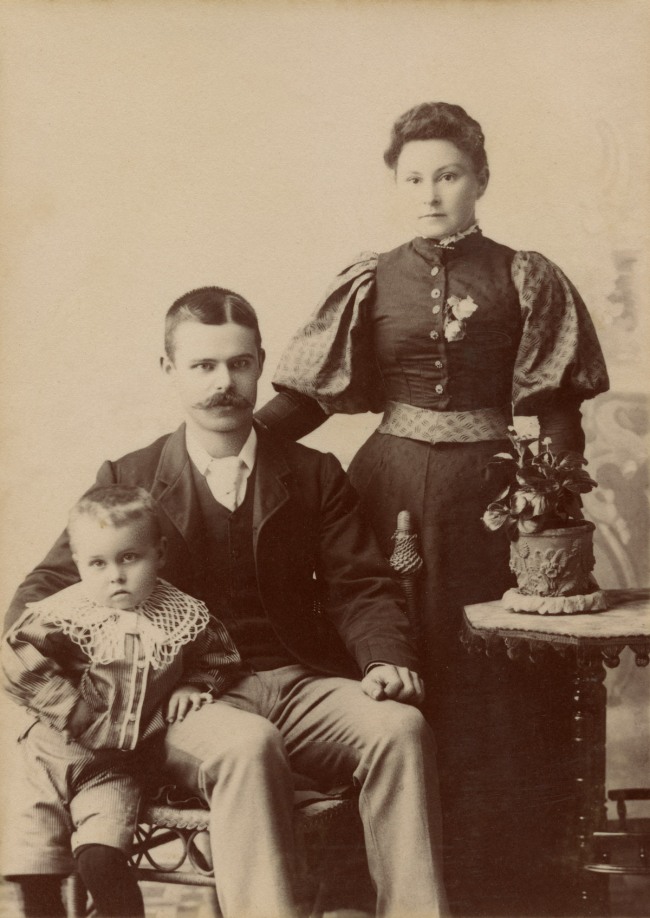


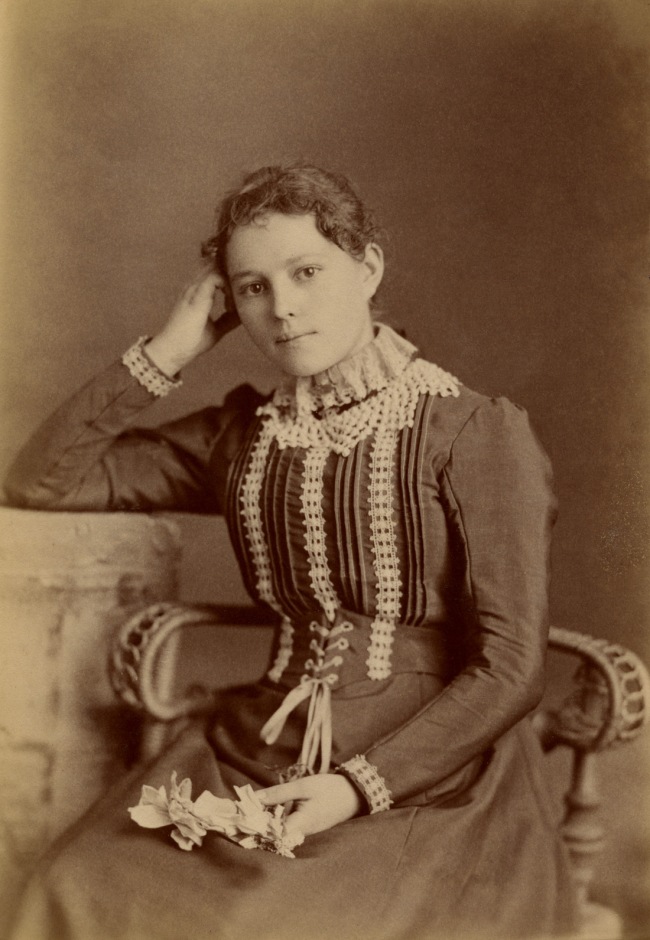
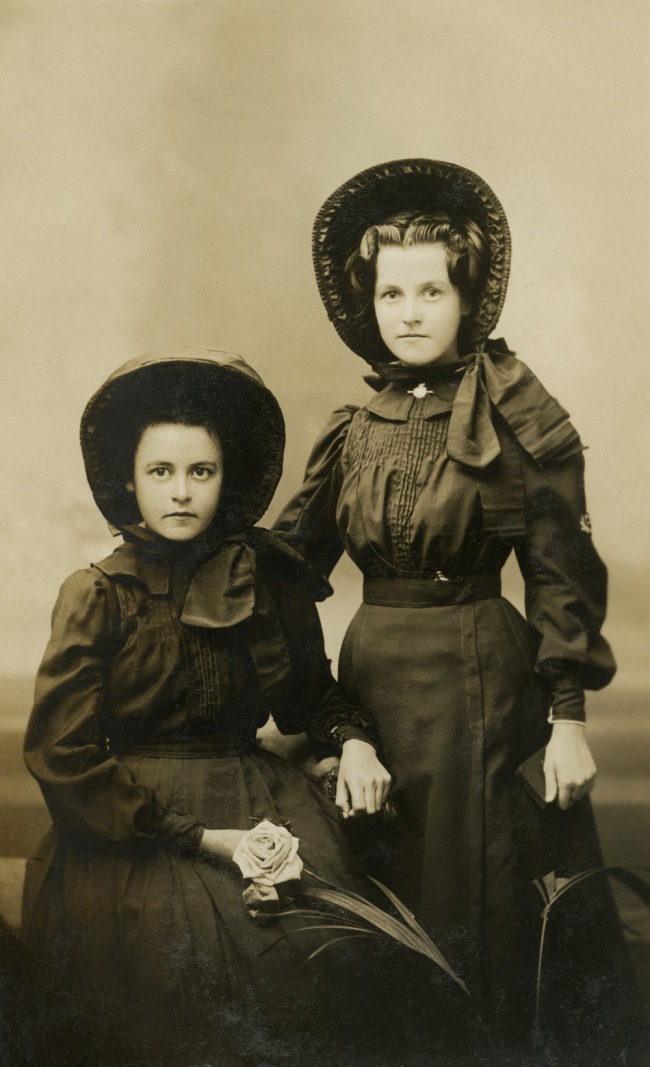
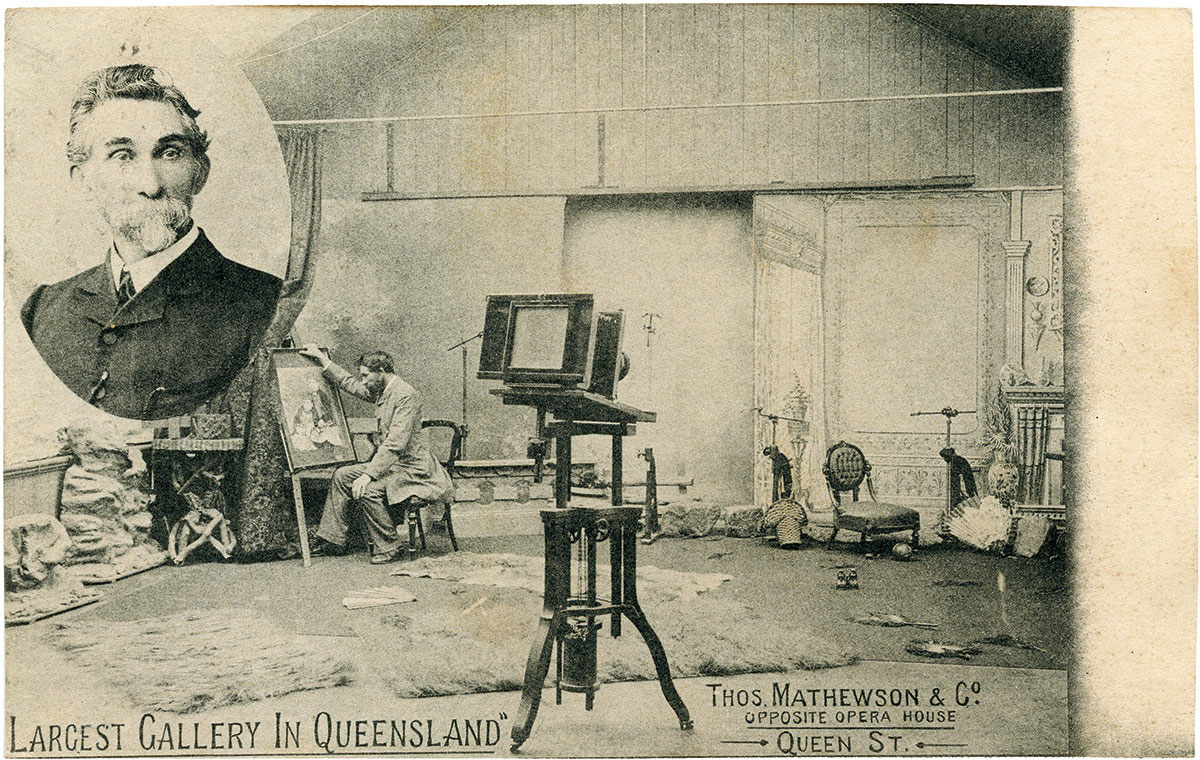
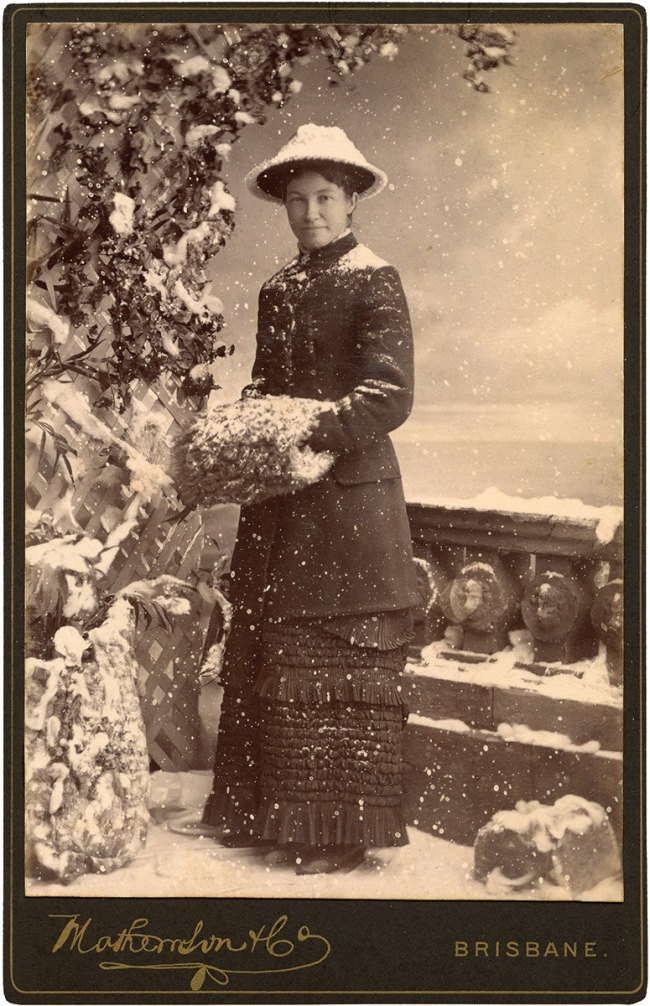
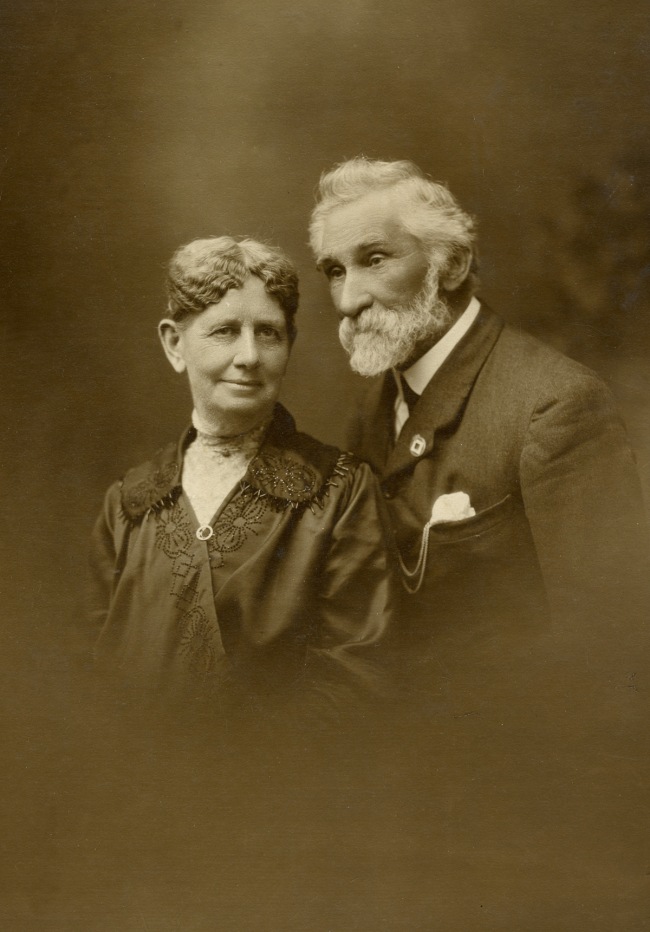



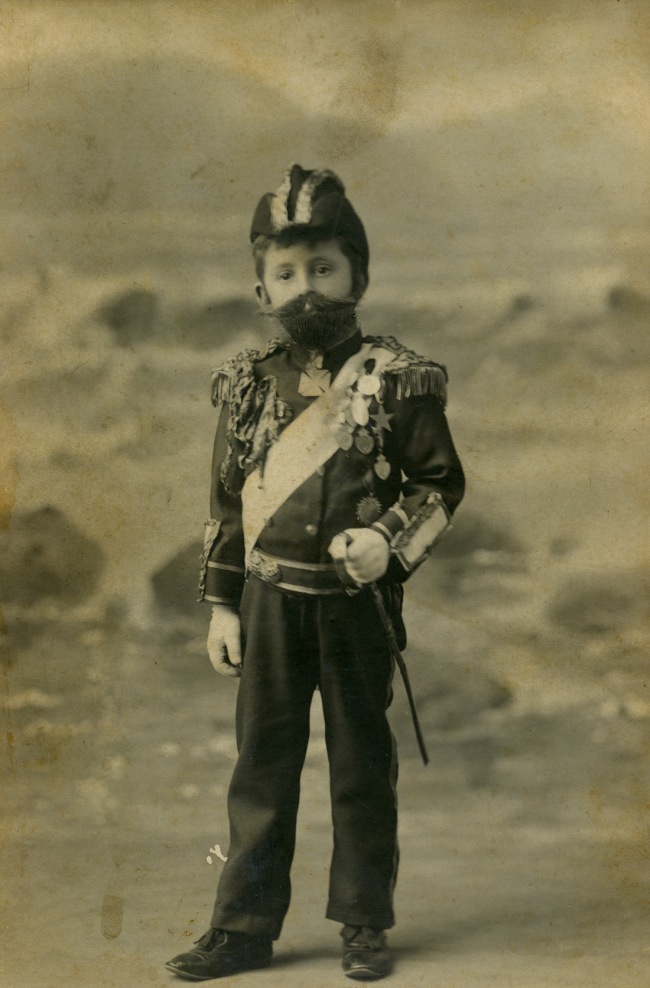



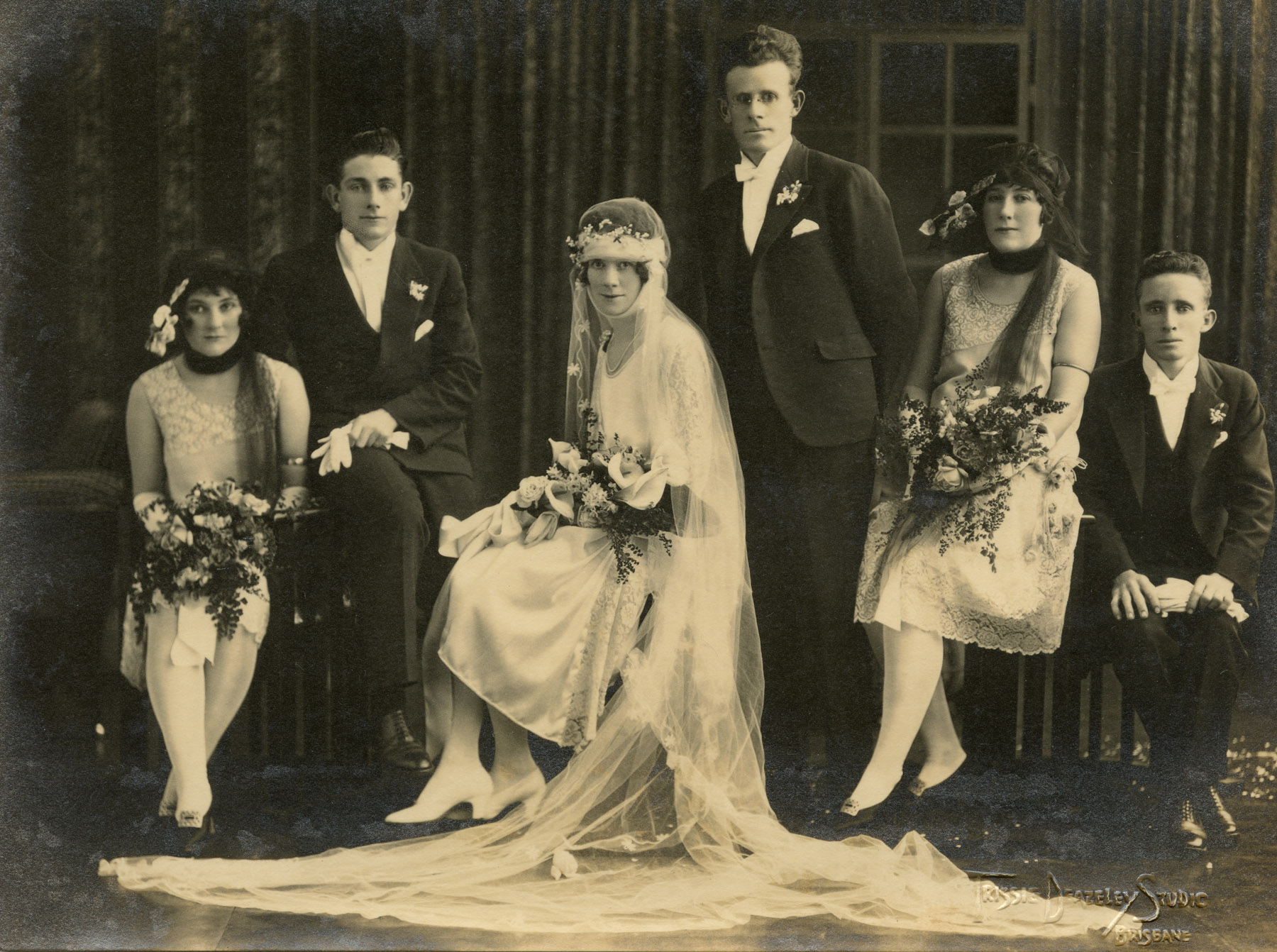
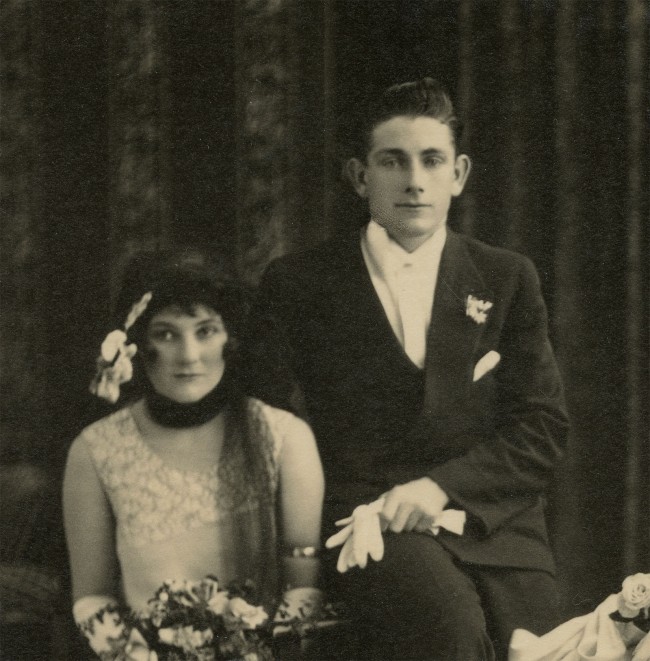



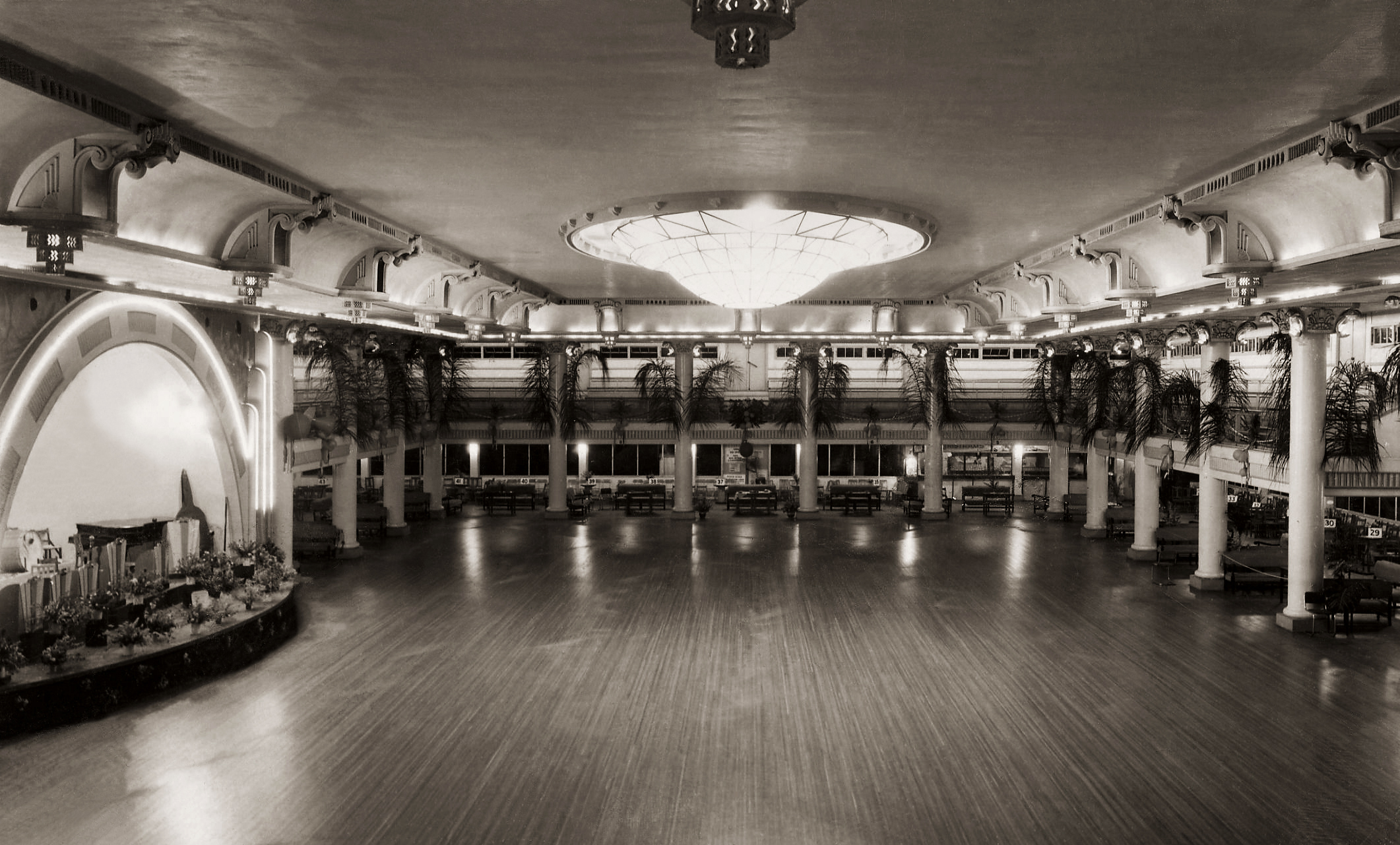

You must be logged in to post a comment.